September 2024 News
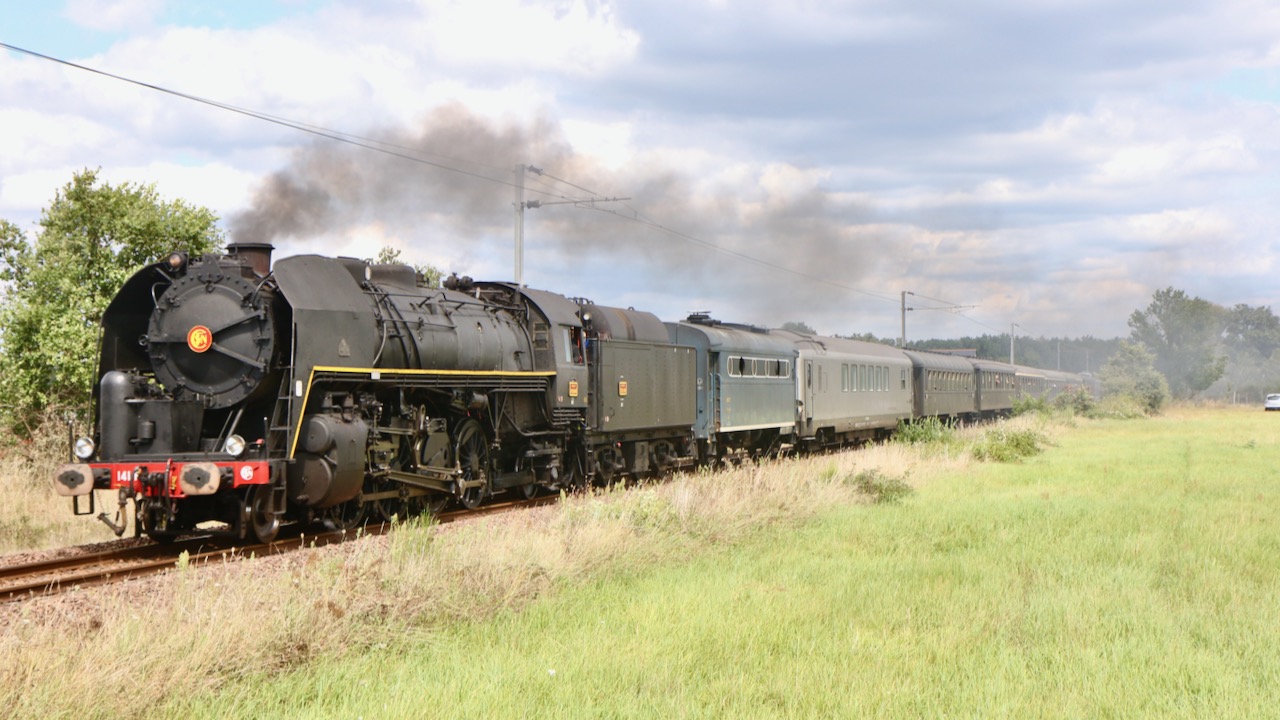
Steam returned to the Saumur – Thouars line on 24th August when AAATV Centre-Val de Loire ran Le Touraine Express from Les Aubrais along the Loire Valley to Saumur, topped and tailed with 141 R 840 and A1A A1A 68540.
With 141 R 840 leading from Les Aubrais, the excursion reversed at Tours on the outward journey. On arrival at Saumur the train then headed to Montreuil-Bellay and Thouars where large crowds gathered by the lineside to witness the event.
Seen above having just crossed PN 232 at Saint-Just-sur-Dive, between Saumur-Rive-Droite and Montreuil-Bellay, and opposite on arrival at Thouars. Photos: Georges Turpin.
With 141 R 840 leading from Les Aubrais, the excursion reversed at Tours on the outward journey. On arrival at Saumur the train then headed to Montreuil-Bellay and Thouars where large crowds gathered by the lineside to witness the event.
Seen above having just crossed PN 232 at Saint-Just-sur-Dive, between Saumur-Rive-Droite and Montreuil-Bellay, and opposite on arrival at Thouars. Photos: Georges Turpin.

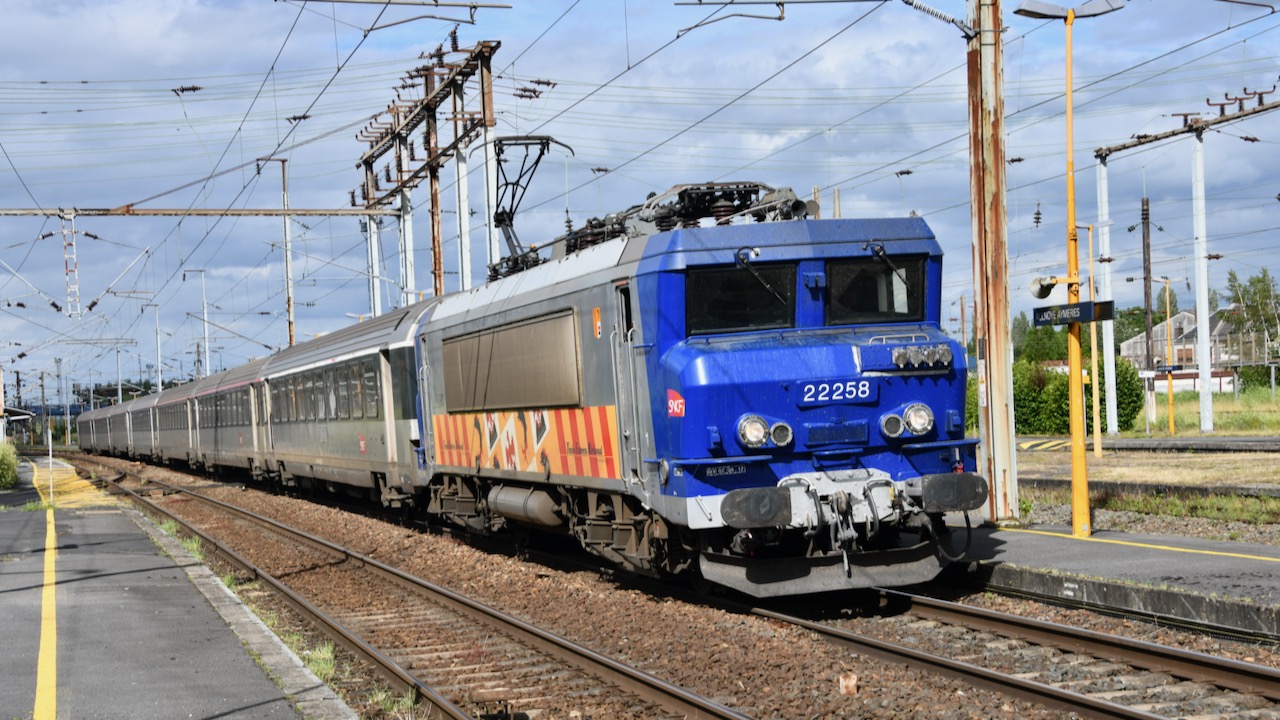
Hauled services with Corail stock from Gare du Nord finished on the 5th July, with Régio 2Ns taking over. One of the final services was the 17.42 Maubeuge – Gare du Nord hauled by push-pull equipped BB 22258, still sporting PACA livery. Seen above waiting to depart from Aulnoye-Aymeries. Photo: Didier Delattre.
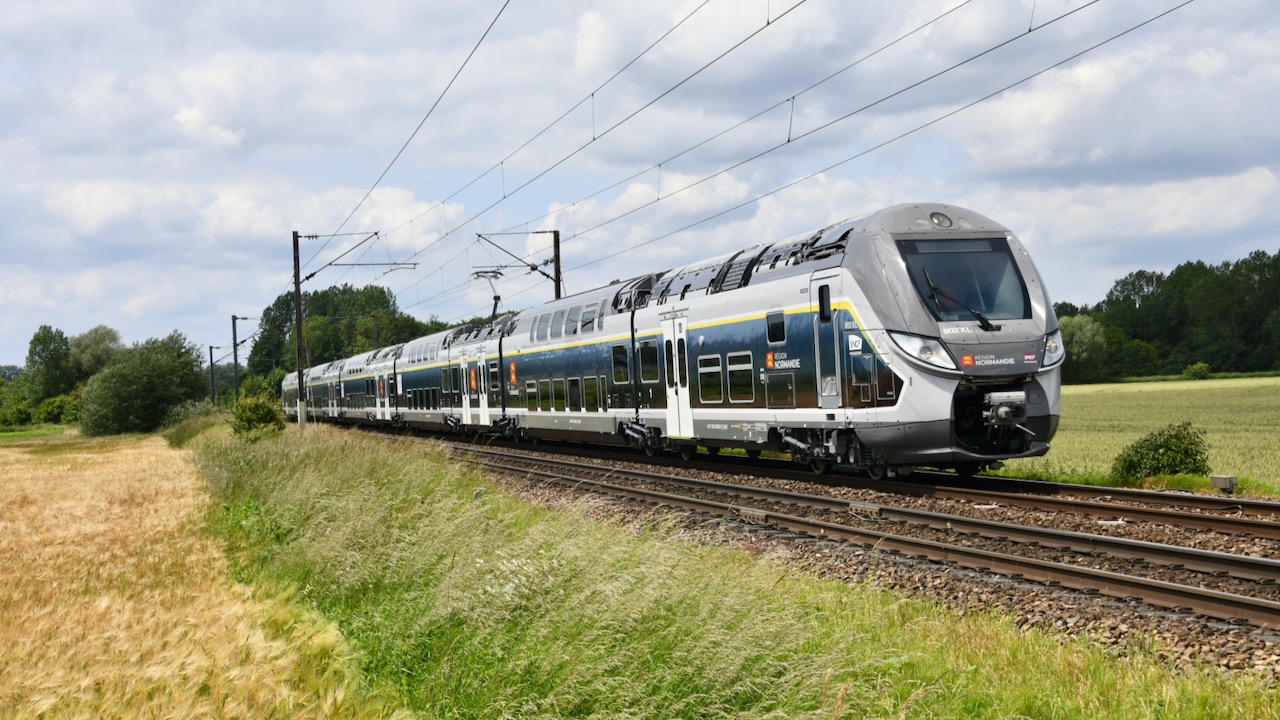
Normandie TER 802XL (Z56803/5607804), part of Normandie's second batch of Omneo Premiums, undergoing validation testing near Somain on 13th June operating as 805783 Arras – Valenciennes. It was formally accepted into service on 26th July. Introduction of Omneo Premium units on Normandie long-distance service saw implementation of compulsory seat reservation. Photo: Didier Delattre.
Disquiet over compulsory reservation
FNAUT has joined other rail users’ associations in expressing opposition to extension of compulsory reservation for TER journeys. Currently necessary for some journeys in Normandie and introduced experimentally from 6th July on TER Fluo routes from Grand Est into Paris, roll-out nationwide is believed to be favoured by SNCF Voyageurs and the regions, though it has been denied by the state railway. FNAUT says that compulsory reservation would be a new obstacle for elderly people and those without smartphones or internet access. Critics believe such a measure would reduce the need to order extra rolling stock to alleviate overcrowding, thus stifling growth at a time when all TER networks are experiencing increased passenger numbers.
Commuters on the Paris – Troyes – Mulhouse and Paris – Châlons – Strasbourg lines complain that they do not always know when their working day will end, and value the ability to board the next-available train to suit their movements. Grand Est points out that reservations are exchangeable and reimbursable free-of-charge until the day before, and 25% of seats remain accessible without reservation. The move is designed to ease overcrowding and ensure that most passengers are seated.
FNAUT also criticised the measure as a further impediment to ease and flexibility of travel. The 13 TER networks each have their own discount cards and offers, and are likely to adopt differing rules if reservations became the norm. It suggests simplification of the 42 national and regional discount cards, as well as extension of the Carte Avantage discount (30%) to TER journeys which currently attract only the local discount (usually 25%).
In response, SNCF stated that ‘there is no project for large-scale extension of the reservation system to TERs. This [the Grand Est scheme] remains an exception that is part of our tailor-made services strategy available to the regions, which are the organising authorities.’ In Normandie the scheme was working well and there had been no negative reaction, it said.
Occitanie région has firmly rejected compulsory reservation. Jean-Luc Gibelin, transport vice president, told Franceinfo: “It is not planned to introduce compulsory reservation on TERs. The position of the région is to make TER as easily accessible as possible, and that is what we do on a daily basis. Booking is not in prospect, especially for commuting”.

In May rolling stock leasing company Akiem opened a new maintenance and overhaul workshop at Ostricourt between Lille and Lens. To mark the event new Alstom Traxx MS3 188.011, part of a batch of 100 MS3s currently being delivered to Akiem, has been named 'Ostricourt' and also carries Hauts de France decals. Seen above on 13th June near Somain being towed by Railadventure DE18 4185.011, running as 46021 Dourges D3 – Forbach. Photo: Didier Delattre.
Pass Rail disappoints
Nevertheless, 1.5 million journeys had been made by mid-August and there were clearly many satisfied customers. Amongst them, France Bleu interviewed Marcel Roblin of Bordeaux who travelled over 12,000km on 59 trains during July, saving €1,300 in fares. Having shared his experiences online, he received a message of congratulations from President Macron.
Several factors combined to limit sales, chief amongst them lack of promotion on social media. The age range appeared to be poorly chosen as teenagers were likely to be travelling with their families on journeys already booked, while young adults were often unaware of the extent of TER networks. It was widely felt that €49 was too expensive when TGV and Île-de-France travel was excluded, leading to extended journey times for those wanting to travel long distances; €19.50 was charged for a couchette berth. One observer pointed to the many destinations outside France that could be reached by competitive low-cost flights. The régions were also unenthusiastic about the pass, fearing abstraction of revenue from their own offers despite the government undertaking to cover 80% of the cost.
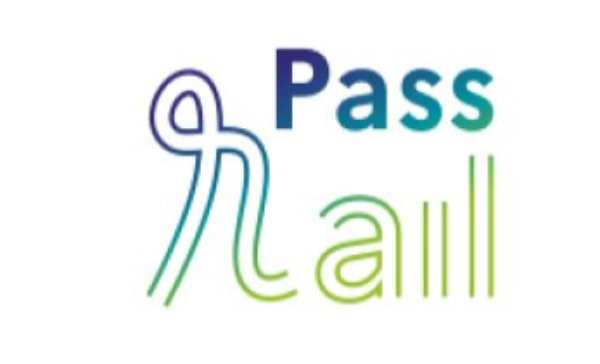
While it’s too soon to predict the future character of the pass, amongst other tweaks the government is considering inclusion of the Île-de-France area for next year.

On a bitterly cold 20th February 2016 BB 75340/341 are seen near Villar-Saint-Pancrace with Train 5789 Paris Austerlitz – Briançon ICN. No alternative route is available for diversion of this night train during engineering work at Livron-sur-Drôme starting on 16th September, travellers being offered a coach departing Briançon at 20.30 taking 10h 50min to Paris. The train will run at weekends during November, with normal service resuming on 8th December. Photo: Christophe Masse.
What next for Trains de Nuit?
The challenges of improving and developing the Night Train network were discussed at a symposium on 17th June organised by Senator Jacques Fernique of Bas-Rhin and the association Destination Trains de Nuit. As well as representatives of SNCF Réseau and Intercités, the regulator AMT and trades unions, speakers included Alain Richard, Europe Express president; Fabrice Toledano, Trenitalia Night Trains marketing director; and Adrian Aumont, Midnight Trains president.
Round Table 1 was largely occupied by discussion of the poor reliability of the current network, with a diagram circulated showing performance during the first three months of 2024 when there were 269 cancellations. Despite the challenges of old rolling stock and motive power as well as overnight engineering works, SNCF said that patronage had grown from 350,000 in 2019 to 770,000 in 2023, an increase of 120%. In the face of doubt as to its commitment, SNCF defended its punctuality and reliability record, in particular the improvements in traffic management, trouble-shooting and diesel loco availability since last winter’s severe operating problems.
Round Table 2 saw the non-SNCF operators set out their views on how the French network might develop. Alain Richard used Austria’s model to illustrate how France could become part of a Europe-wide network, suggesting dedicated routes to improve reliability of overnight freight and ICN trains, leasing of interoperable locomotives, and design of rolling stock suitable for both night and daytime operation.
Fabrice Toledano reminded the meeting that Thello (now Trenitalia France) was the first foreign operator to enter the French market. The ICN offer should be guided by customer expectations he said. High operating costs stemmed from the Night Train’s character as train, hotel and catering service, with only one trip possible per 24h, thereby making investment less attractive in comparison with intensively-used day trains. Nevertheless, Trenitalia has 70 new cars on order for Milan – Syracuse, demonstrating its desire to develop the market (though it has a public service obligation to operate such routes).
This view was echoed by Adrien Aumont who outlined Midnight Trains’ project for a premium service that had foundered due to regulatory problems and lack of interest from investors (see July News). He believed that night trains could never be a low-cost product. Rather than seeking to compete with airlines, he stressed the need for high-quality rolling stock to justify high fares. In particular private facilities (berths for one or two people, with toilet and shower) were essential to meet customer expectations.
In conclusion, it remains the case that no further routes are slated for introduction in the short term, and one speaker called the current network ‘a waste of public money’ unless it was truly the nucleus of a much wider network. With government paralysis over the summer, the future of the 2030 plan is uncertain. Outgoing transport minister Patrice Vergriete had already expressed his doubts about further expansion in an interview with L’Usine Nouvelle in May, as a result of which it seems that an order for new rolling stock is unlikely to be placed any time soon.
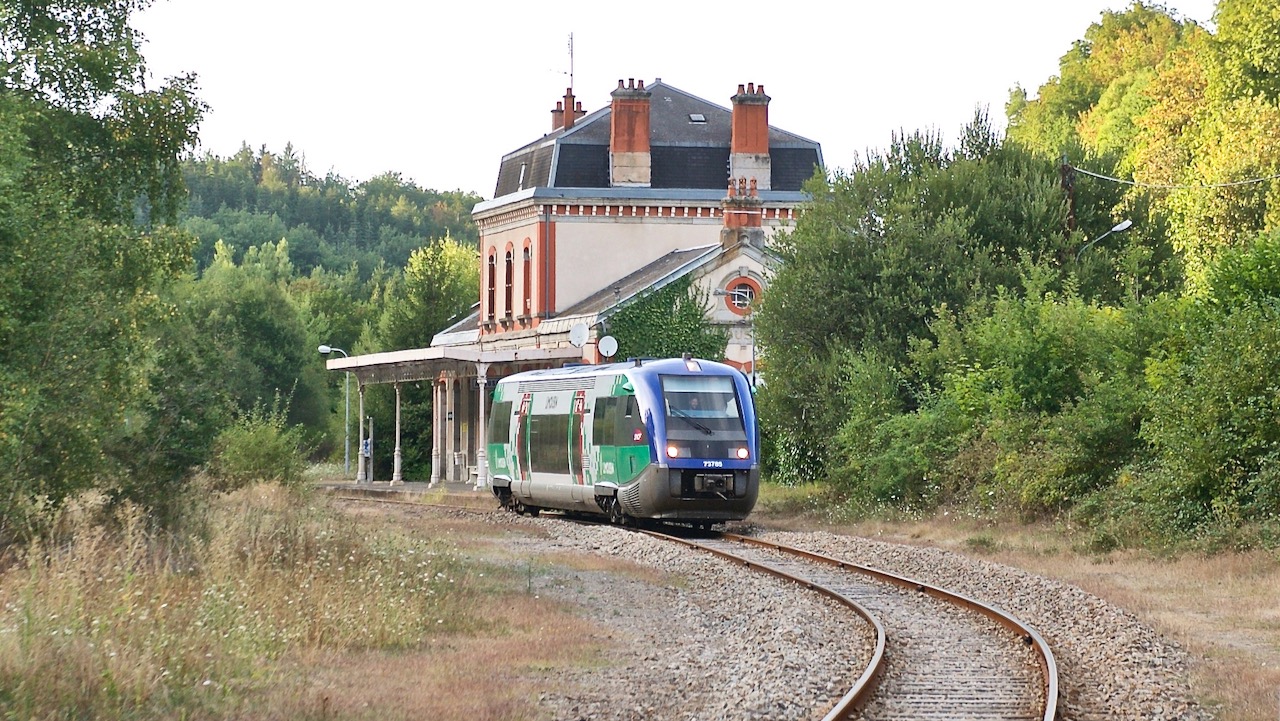
On the evening of 9th September 2016 X 73785 forming the 17.11 Limoges – Felletin has dropped off a handful of passengers at Aubusson. Having waited for them to walk alongside the track to the passage à niveau, it is seen departing for Felletin, where the crew will spend the night before returning to Limoges the following morning.
Felletin closure threat
One of Nouvelle-Aquitaine’s least-used lines, Busseau-sur-Creuse to Felletin, is threatened with closure due to the poor state of its infrastructure according to reports seen by trades union CGT. As well as life-expired rail, the line’s two tunnels are in need of major work estimated to cost €12 million. The 36km branch, stub end of the PO line that formerly ran to Ussel (closed 1979), is currently served by two daily trains at 06.23 and 16.41 from Felletin to Limoges, with a Saturday extra at 11.12.
While the Limoges – Guéret section of the transversal route to Gannat (Clermont/Lyon) was upgraded and resignalled in the 2010s, the eastern portion has received little investment except for recent work at Montluçon in connection with improvements on the line northwards to Bourges. Track renewal between Montluçon and Commentry (14km) is scheduled for late 2025 but a decision is awaited on upgrading eastwards towards Gannat, including replacement of manual block signalling, to accommodate ore trains from the Imerys lithium mine to be developed at Échassières (see August News). This investment would assure the future of the eastern section. Withdrawal of the Felletin service would leave the central Guéret – Montluçon portion (78km) with just two daily trains and vulnerable to closure if AURA’s Lyon – Bordeaux IC proposal comes to nothing.
The news is hardly surprising as the already-modest patronage has slumped since covid. In 2016 the branch’s three stations attracted some 12,000 passengers, even with just one daily A/R, whereas 2023 saw fewer than 1,800 despite resumption of weekend trains that attracted only 500 additional passengers. The scant service involving a lodging turn at Felletin must be very costly to operate. Nouvelle-Aquitaine and SNCF Réseau are understood to be considering options but the line does not figure in the région’s rail development plans. According to the CGT, unless funding is made available for remedial work, trains would cease running in December 2025.
On 31st August 2017 a railtour ran from Guéret to Felletin calling at Busseau-sur-Creuse and Aubusson. Having dropped most passengers at Felletin for the afternoon, the autorail is about to depart on a return trip to Busseau. Photo: Pete Brendon.
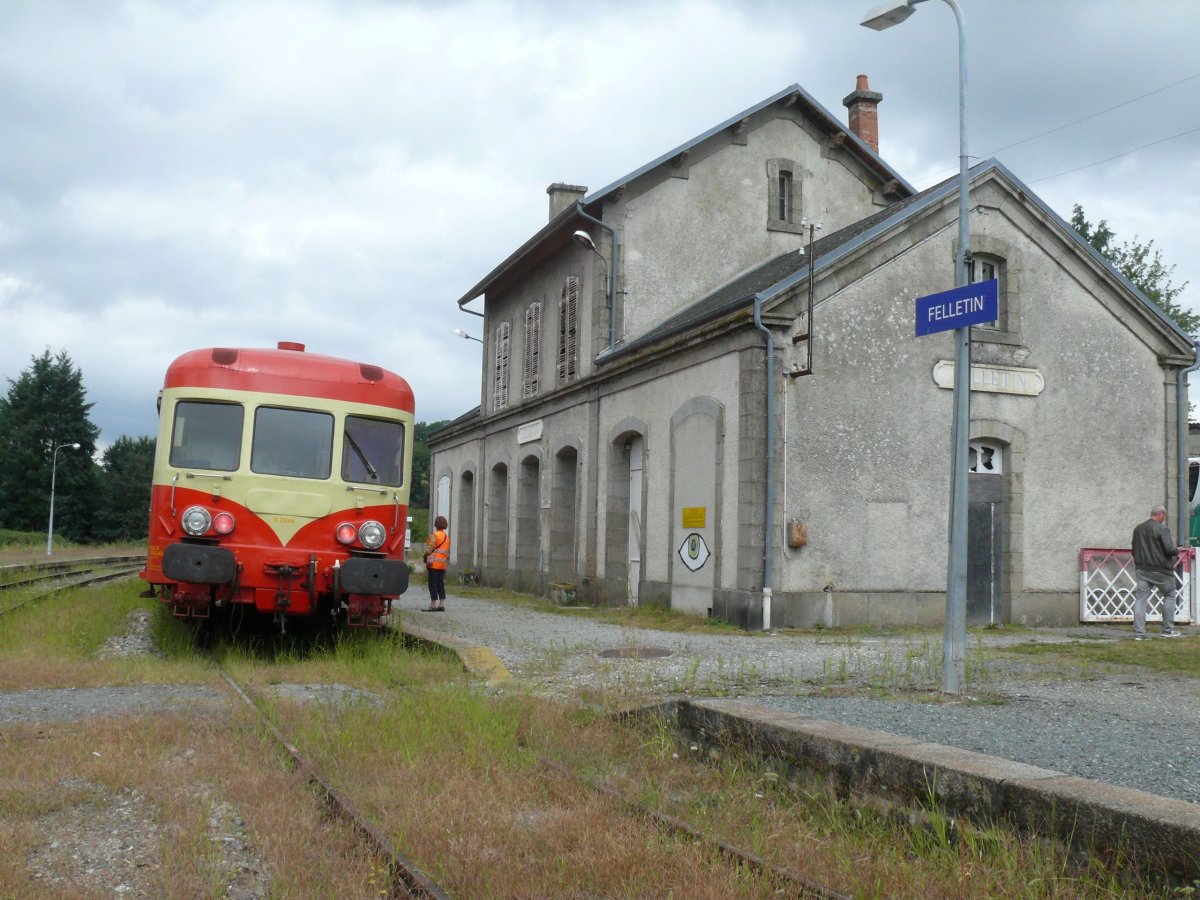

The 'Train Autonome' Hauts de France Regio 2N 117M ( Z55500 Z 55733/5506734) enters Gare du Nord on 4th June. Visible on the cab roof is the camera for identifying signals when the train is operating in automated mode. Photo: Didier Delattre.
News in brief
SNCF half-year results. SNCF Voyageurs reported revenue up by 8.1% over the same period in 2023, with all passenger businesses recording increased patronage. TGVs carried 65 million people, up 7.7%; TER journeys grew 11%, as did the number of Transilien passengers, while Intercités saw journeys up 10% to 5.6 million.
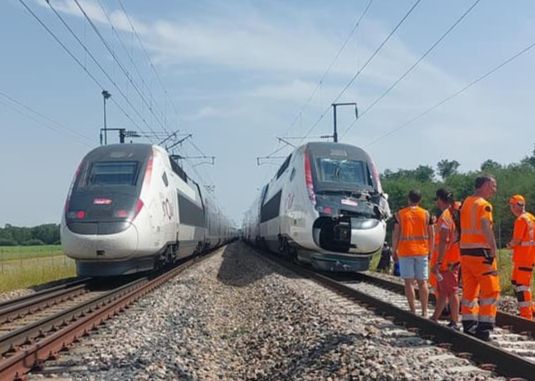
LGV Sud-Est. Having escaped the chaos resulting from 26th July’s acts of sabotage, both LGV Sud-Est and the classic route were hit by overnight storms on the 30/31st. All trains were stopped between Paris and Lyon/Dijon due to fallen trees and damage to the OHL. Duplex Set 262 heading TGV 5380 06.12 Lyon Perrache to Rennes/Nantes hit a tree at speed near Saint-Florentin, damaging the front end; fortunately no one was injured. Services on the classic line resumed from 14.00 and TGV departures from Gare de Lyon at 17.00. After a wait of several hours, passengers on the stranded TGV were transferred to another train sent from Lyon in mid-afternoon.
Photo: SNCF.
Cévenol 2025 works. Annual maintenance work on the Gorges de l’Allier tunnels between Langeac and Langogne will next year be carried out between 09.45 and 16.15 daily instead of the usual three-month complete line closure, allowing a partial service to operate for the first time in many years.
Wabtec. Is to merge its two manufacturing sites in Indre-et-Loire with a €30 million investment in expansion of the plant at Saint-Pierre-des-Corps where braking equipment and platform screen doors are made. The former Faiveley site at nearby La Ville-aux-Dames will close by 2026.
Nancy – Contrexéville. The European Investment Bank has agreed a €90 million loan towards the cost of reopening this line (see June News), the work now expected to be completed in early 2028.
Hupac. From 16th September, Swiss operator Hupac is doubling its intermodal service from Antwerp to Perpignan and Barcelona from five to 10 train pairs a week. Having taken over operation between Thionville and Avignon from Fret SNCF at the beginning of the year, Lineas now assumes full responsibility, with its own drivers to Portbou and its own locomotives between Antwerp and Perpignan where part of the train is added/removed. Captrain España takes the train forward from Perpignan to Barcelona El Morrot.

Lauterbourg. Residents between Strasbourg and Lauterbourg complained at last month’s diversion of 37 daily freight trains to the line whilst the Rheintalbahn route in Germany was closed for upgrading, the maire of Wantzenau filing a legal objection against SNCF Réseau. Locals regarded the line’s use for heavy freight as dangerous considering SNCF’s long-standing position that the decrepit infrastructure could not support an additional five A/R passenger trains daily. Paris – Stuttgart TGVs were also diverted away from their usual route by the closure, adding 30min to the journey time. Photo: Rue89 Strasbourg/CB.
New lines statistics. Figures for 2023 show a 16% increase in passengers using the Pau – Bedous line, with Oloron-Sainte-Marie up 10% to 122,000 and Bedous, where earlier results had been disappointing, up 37% to 22,700. On the other hand, the reopened Rhône right bank service from Nîmes/Avignon to Pont-Saint-Esprit is carrying less than half its projected traffic, with 75,000 journeys in 2023 against estimates of 200,000. The route is handicapped by an awkward timetable as there is still no crossover at Pont-Saint-Esprit.
Sateba. This 100-year-old French manufacturer of concrete sleepers and railway infrastructure components is to be acquired by Vossloh AG.
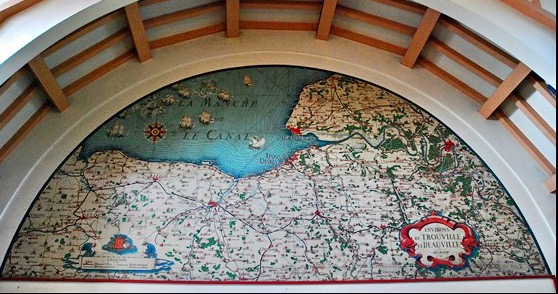
Trouville-Deauville. Following completion of accessibility works, the listed Neo-Normande station building is to be modernised next year and the interior restored. The barrel-roofed halle contains two 1932 frescoes by artist Louis Houpin, well-known for his railway posters. Photo: Ville de Deauville.
Mohon Correction. August News stated that BB 9301 and BB 9337 were destined for ACPR 1126 at Toulouse. This was incorrect. They are destined for APBB9301 at Toulouse Reynal, but will remain with CFTST at Vierzon on a temporary basis.
DB Cargo France. Two new intermodal services will start in January, including DB Cargo France’s first own-account operation carrying swap-bodies from Metz and Nancy to Valenton in southeast Paris five times a week. Three road hauliers have already reserved 80% of the space. In addition, a new Valenton – Daventry service for an unnamed UK logistics company will operate two or three times a week. Whilst this will be diesel-hauled in France, the Metz service requires an additional eight electric locos. With the recent takeover of traffic relinquished by Fret SNCF, DB Cargo France expects intermodal to rise from 27% to 40% of its business this year.
Verberie. The 30km Ormoy-Villers – Verberie – Longueil-Sainte-Marie freight-only line north of Paris is closed until 20th December for rerailing and replacement of pointwork at several locations.
Serqueux – Gisors. Fallout from the closure of this service on 22nd July at four days’ notice (see August News) included protests from local officials of the towns served and users’ association FNAUT which said that ‘everything has been done to make the trains unattractive to passengers’. FNAUT suggested it could work with Normandie région to plan a more attractive service with at least seven A/R daily including weekends, better connections at each end, and through ticketing from Serqueux to Paris.
Maurienne reopening delayed. A joint announcement on 31st July from Savoy département and SNCF Réseau confirmed fears that the line would not reopen in November as scheduled. More unstable ground had been discovered during the rebuilding, almost doubling the amount of work necessary before trains can resume running, now likely to be in ‘the first quarter of 2025’.
Winter Olympics. France’s candidature for the 2030 Winter Olympics was provisionally approved on 24th July, with a 1st October deadline for the State and the two régions involved (AURA and PACA) to confirm their financial guarantees. These include substantial sums for improving rail access to the resorts concerned.
TGV cuts. SNCF has confirmed that Laval is to lose one morning Paris service and one evening return in next year’s revamp of TGV timetables. At Lunéville in Meurthe-et-Moselle and other towns served by TGV 2584 (05.39 from Strasbourg) departing at 06.49, officials are protesting against a proposed 90min later arrival in Paris which they say would make daily commuting impossible.
La Ferté-Gaucher. Rival groups are pressing for reopening of the 19km link to Transilien Line P at Coulommiers, closed in 2002, or conversion of the alignment into a voie verte.
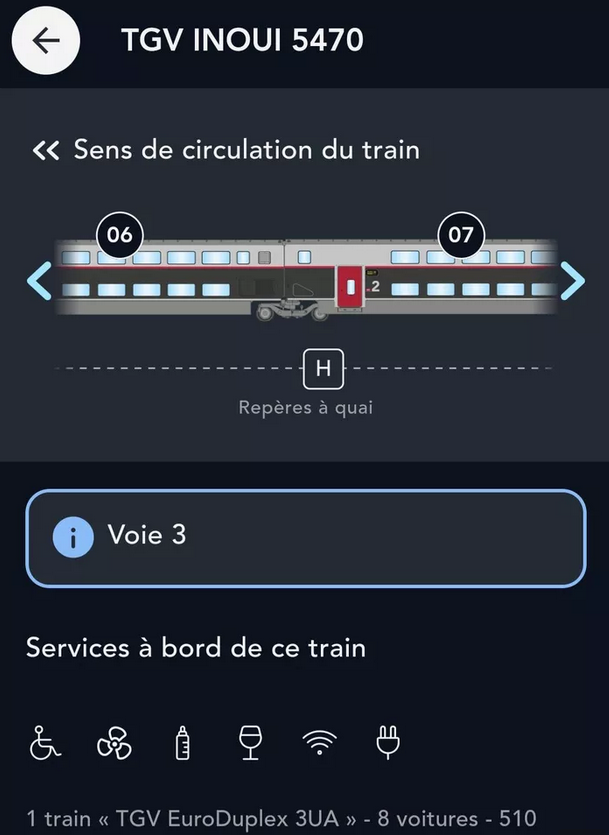
SNCF Connect. Improvements to the app introduced in time for summer include the ability to specify connecting time between trains, either in the same station or between two stations in the same city such as Lille-Flandres and Lille-Europe, from a minimum of 15min to 2h 30. On ticket downloads, the platform number is shown, and for major stations also the repère (where to wait on the platform). Persons with reduced mobility can now check whether there is level access to platforms, and if there are lifts. For onward travel, timetables are available and tickets can be bought for public transport in 30 towns and cities.
FNAUT issued another call for SNCF to simplify and reduce the number of websites (23) and apps (five). A meeting between passenger groups and SNCF Voyageurs is to take place this month. Photo: SNCF Connect.
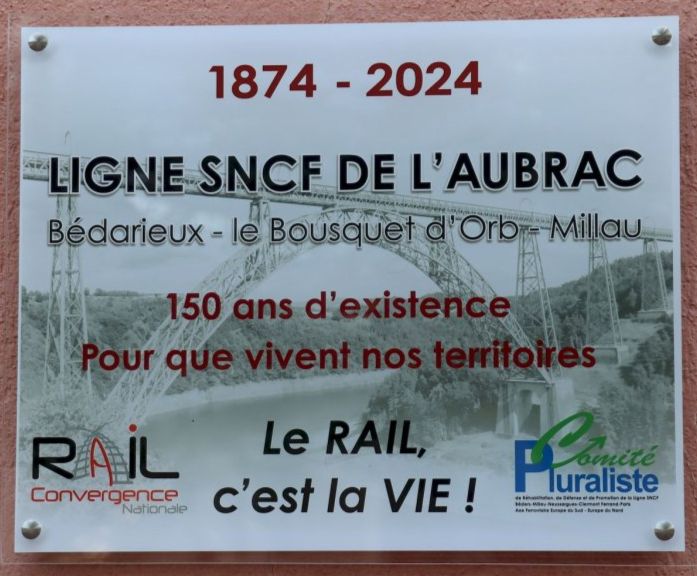
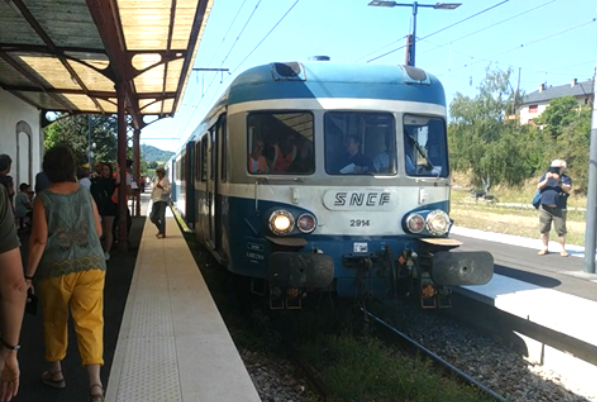
Aubrac anniversaries. Unveiling of a plaque at Bédarieux station on 10th July to commemorate the 150th anniversary of the Aubrac line opening to Millau was followed a month later by celebrations at Marvejols 140 ans du rail en Gévaudan to mark the 140th anniversary of the Translozérien railway linking the town with Mende. On 11th August a special train operated by Association AP2800 ran from Langogne to Mende and Marvejols, seen arriving there at 12.20 with X 2914 leading. The train made an afternoon A/R to Mende before returning to Langogne.Photo: Collectif des Usagers des Transports du Haut-Allier.
Loos. Most TERs between Lille and Don-Sainghin were replaced by buses from 12th to 25th August whilst a railway bridge was installed between Loos and Haubourdin over the new LINO Sud (Liaison Intercommunale Nord-Ouest) road under construction.
CF de Provence. Up to 30% of the timetable had to be cancelled on very hot days during July and August due to inadequate air-conditioning in some of the railcars. Conditions were described as ‘particularly strained’ for both passengers and staff.
Nice – Tende. Locals protested during August against the 16-month closure starting on 2nd September for rehabilitation of Braus tunnel (5,938m); staff took strike action on 13th August. No trains will run between Drap and Breil-sur-Roya, and only a limited Trenitalia service thence to Tende.
Nîmes – Le Grau-du-Roi. Will be partially closed from 23rd September for four weeks and throughout for a further week whilst track upgrading is carried out.
Artouste. The Petit Train d’Artouste has been sold by its owner Société Hydro-Electrique du Midi for a symbolic €1 to the commune of Laruns, which has managed it since 2019. Developed from lines that carried materials for construction of the Midi railway’s hydro-electric schemes in the 1920s, the 500mm gauge railway is to be modernised and further developed as an adjunct to the Artouste ski resort.
The Convention of European Railway Societies - Saturday 19th October 2024
Thringstone Club, 126 Loughborough Road, Thringstone, Coalville, Leicestershire LE67 8LR
10am to 4.30pm. Admission – Adults £5, accompanied children under 16 free.
We are participating in this event along with the Austrian, German, Italian, Scandinavian and Swiss Railway Societies. There will be stands and layouts from each Society plus trade stands from Contikits, Scograil and Mount Tabour.
More details of exhibits can be found on the UK Model Shops Website
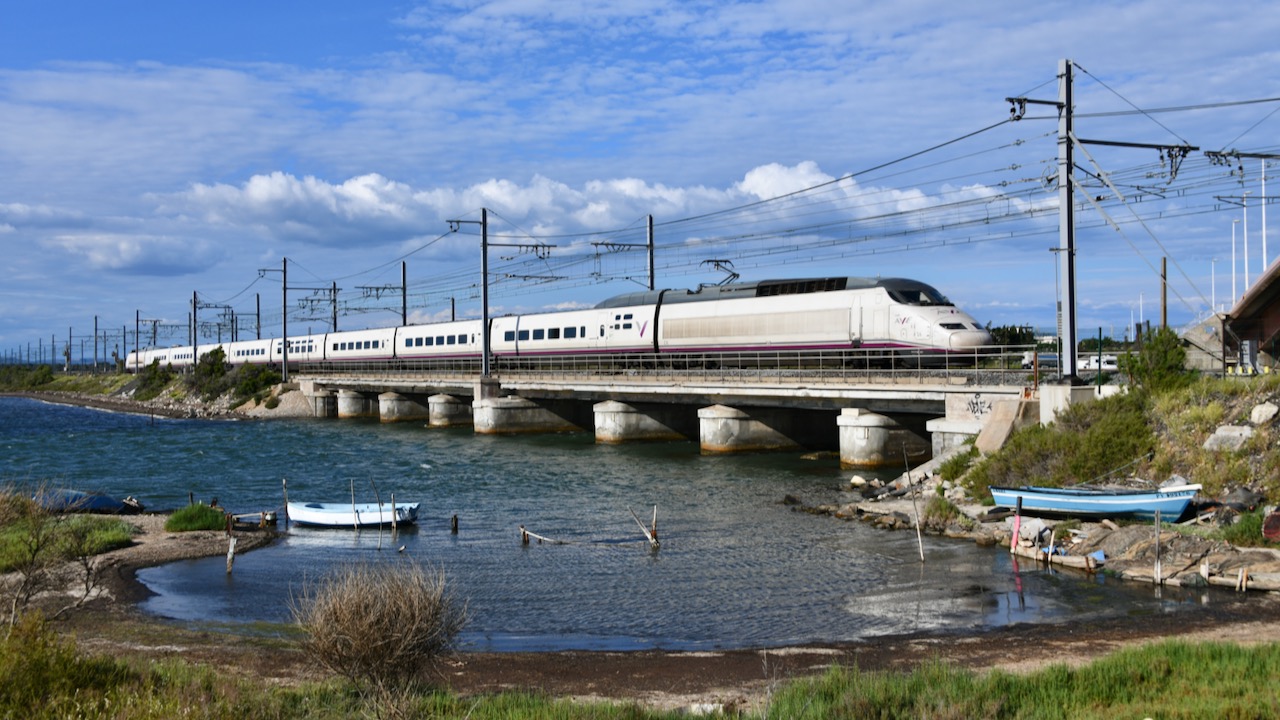
RENFE S-100 16 passes Port-la-Nouvelle with AVE 9724 Madrid – Marseille on 2nd June. Photo: Didier Delattre.
Connection Failed
A Greenpeace study of passenger services between major European cities has highlighted the huge potential for direct cross-border trains that could replace short- and medium-haul flights. Connection Failed looks at 990 routes between 45 cities, only 13% of which are currently served by direct trains, while 69% have direct flights. According to Greenpeace, 419 such routes could be served by trains taking under 18h, but only 114 are. Of the 305 missing routes, 139 could be served by day trains taking under 12h over existing tracks and 166 by night trains with journey time of up to 18h.
Paris is identified as the city with the fourth highest number of direct international train connections, after Vienna, Munich and Berlin, with 13 of 44 routes to other European cities served by direct trains. Nevertheless, a large number of routes are unserved and Paris is better connected to the rest of Europe by air than rail. Given the extent of Europe’s high-speed network, the number of cities analysed that do not have direct day trains from Paris is surprisingly high at 29. The most obvious missing connections are to Rome and Madrid, each with over 2 million air passengers a year and in the top five of Europe’s busiest short-haul flight routes without through trains. For night trains, based on air passenger figures the most important routes from Paris would be to Lisbon and Copenhagen.
The study also looked at Marseille, Lyon and Toulouse, again finding them much better connected to other European cities by air than by rail. Apart from Lisbon and London, each of which have particular problems for through trains, Marseille – Munich, Lyon – Amsterdam and Toulouse – Brussels are the busiest air routes that could easily be served by day trains.
It's worth noting how the situation has declined over half-a-century. In 1969 Paris had through trains or through coaches to 28 out of 38 cities surveyed (ie excluding French and UK cities apart from London), and many others extending as far as Moscow, Athens and Istanbul. Lyon, Bordeaux and Toulouse also had international trains, for example Bordeaux – Lyon – Geneva – Munich. Greenpeace offers no simple explanation as to why there are so few direct trains today. Factors include lack of infrastructure investment, shortage of suitable rolling stock, lack of interoperability, lack of political will and support, regulatory issues, high access charges, and lack of co-operation between operators.
Greenpeace calls on governments to take action and for the EC to speed up technical and legal harmonisation. It also urges policymakers to support purchase of new and secondhand rolling stock, develop a unified train information system encompassing all operators, and a unified booking system for purchase of through tickets.
Paris – Madrid. With SNCF running from Paris to Barcelona, and from Barcelona to Madrid (Ouigo), there would seem to be no reason why there should not be through Paris – Madrid services aimed at the 2.5 million annual air passengers on the route. Similarly, RENFE is operating between Madrid and Marseille/Lyon and awaiting clearance to run Paris – Lyon, opening up another possibility for through Paris – Madrid service.
Lack of will; lack of co-operation? RENFE and SNCF high-speed trains side-by-side at Perpignan. On 14th August 2023 RENFE S-100 set No 21 awaits departure at 09.48 with AVE 9736 08.22 Barcelona – Lyon (13.20) alongside TGV 6252 10.04 to Paris. Photo: Ben Pattison.
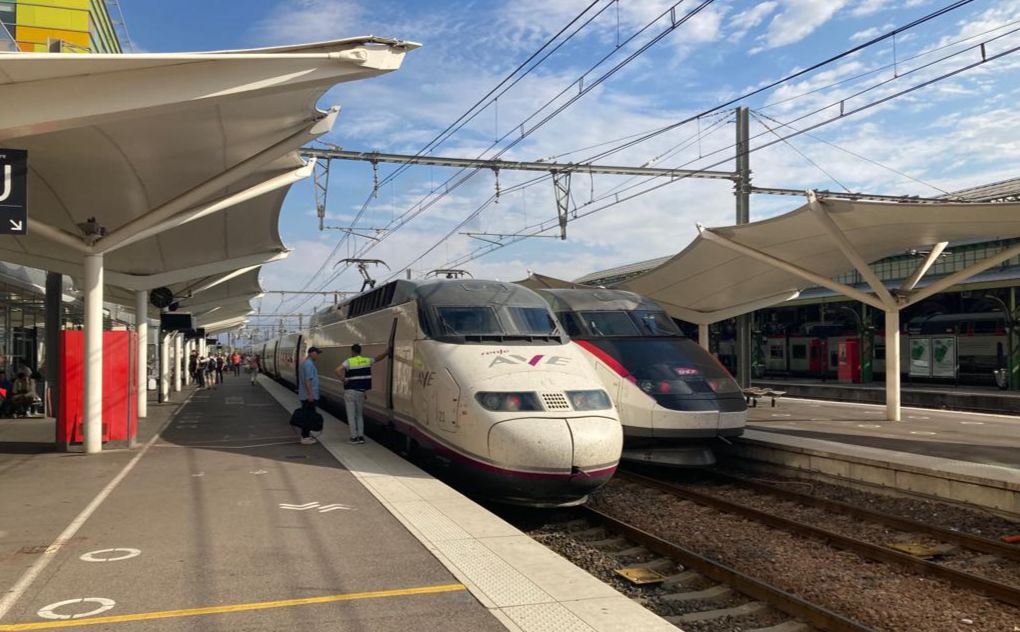
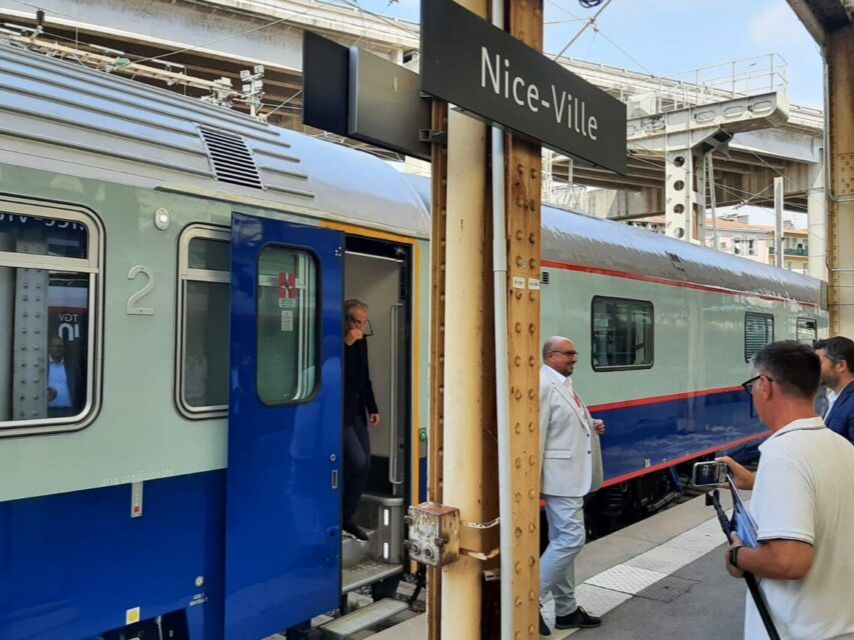
Nice – Milan. Arrival in Nice on 31st July of the inaugural Espresso Riviera tourist train from Milan (see August News) gave Trenitalia the opportunity to set out its plans for regular service from the Côte d’Azur to Italy. Trenitalia France President Marco Caposciutti expressed frustration at the continued closure of the Maurienne Valley line, reopening now delayed until spring 2025, and said that all certifications were in place for opening a second route from France to Italy. The aim is to extend Paris – Lyon operations to Marseille ‘as soon as possible’ and to launch a Nice – Genoa – Milan service by 2026. Later, the two services would be integrated to provide through trains between Marseille and Milan.
The shape of things to come? Espresso Riviera ran from Milan to Nice for the first time on 31st July. Observers found few travellers aboard subsequent trains, with the Nice departure on 17th August attracting only four passengers. With only a diesel available for the Ventimiglia – Nice section (Lineas BB 75328) the Monaco stop had to be abandoned as diesels can only pass through but not stop there.
Photo: ©actuNice/CBL.
Through ticketing. ‘Political Guidelines ‘ issued in connection of Ursula von de Leyen’s (successful) bid for re-election as EC President highlighted again the difficulties of booking cross-border rail travel. She said that the Commission would propose a new Regulation on Single Digital Booking & Ticketing so that “Europeans can buy one single ticket on one single platform and get passengers’ rights for their whole trip”. This would appear to be a simplified version of the Multimodal Digital Mobility Services Regulation (MDMS) put forward for discussion in 2021 and which has yet to come to fruition.
SERM Basco-Landais
Despite missing out on SERM status in the first tranche of designations announced on 27th June (see August News), partners in the Basco-Landais cross-border project are continuing work to produce the ‘road map’ required by the transport ministry before funding eligibility is granted. In a first stage of introducing more frequent trains between Bayonne and Dax (see February News), where patronage has doubled since 2019, five A/R will be added in the December timetable. A half-hourly service is planned for 2026.
Development of the busiest intermediate station, Saint-Vincent-de-Tyrosse (242,000 passengers in 2023), as a multimodal hub (PEM) is taking place in stages through to 2028 to cope with expected traffic growth as the number of trains increases. New or reopened stations are now planned at Bidart between Guéthary and Biarritz, Tarnos north of Bayonne, and Lahonce east of Bayonne on the single track to Puyôo and close to the Centre Européen de Fret (CEF) at Mouguerre.
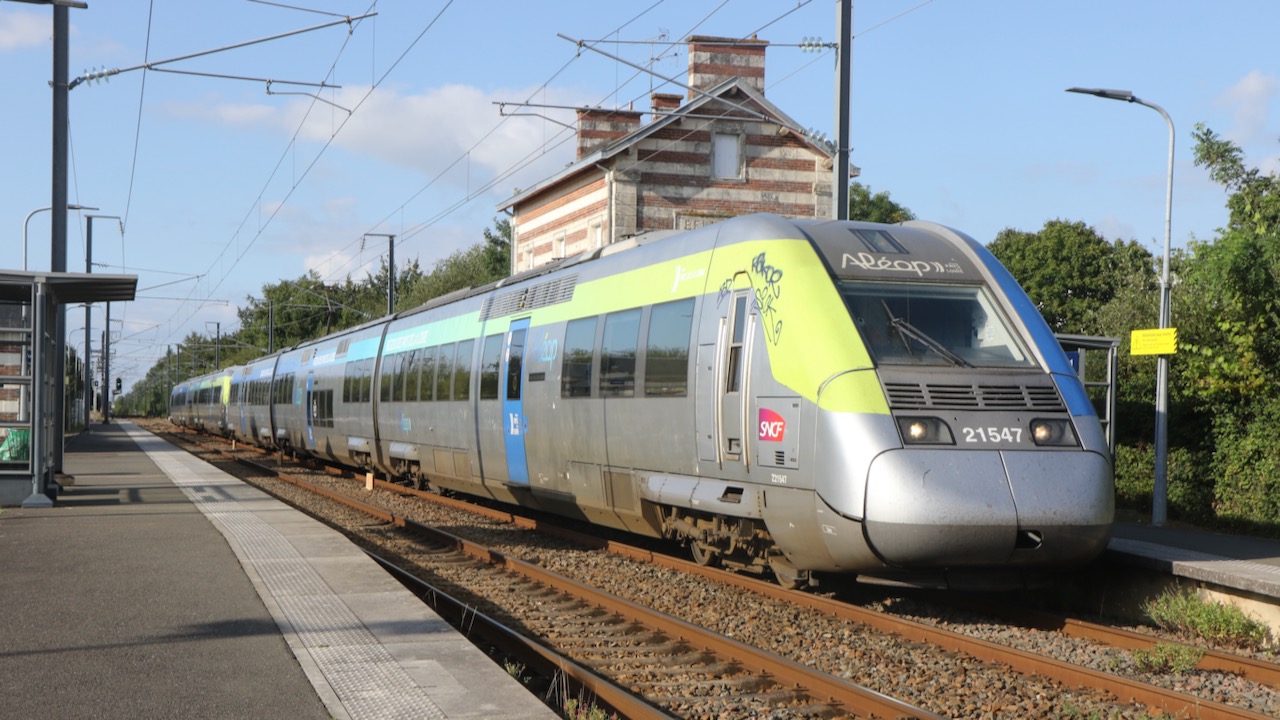
57 Class Z 21500 EMUs were introduced between 2003/04 as an all electric development of the X 72500 diesel Automoteur TER with similar external styling. With a top speed of 200km/h they appear to have been more successful than their diesel cousins and are now undergoing mid-life overhauls. They are now operated by Bretagne, Central-Val de Loire and Pays de la Loire régions, Nouvelle Aquitaine having sold theirs, making them a feature of north-western France. Eight units have been adapted to operate on the LGV Bretagne-Pays de la Loire and had their number prefix changed from Z 215 to Z 217. On the evening of 14th August Z 21547/Z 21553 are seen at Belleville in Pays de la Loire Aléop livery with TER 858843 18.08 Nantes – La Roche-sur-Yon. Photo: Georges Turpin.
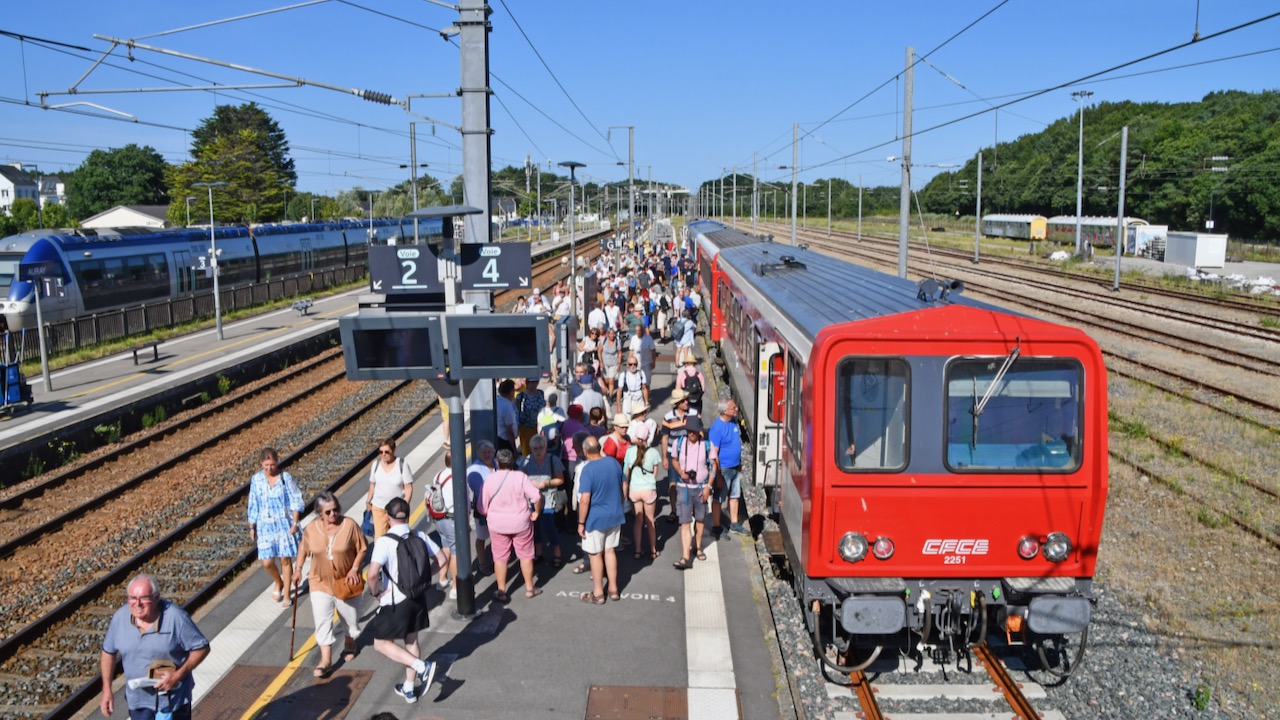
Train Touristique Napoléon
Train Touristique Napoléon operated by Chemin de Fer du Centre Bretagne (CFCB) between Pontivy and Lambel-Camors ran a further 20km through to Auray several times during the summer, following upgrading of the freight-only line in 2022-23. On 11th August the train comprised railcars X 2251, XR 6241, XR 96005 and X 2208, seen (right) just north of Pluvigner. Judging by the crowds on arrival at Auray (above), the train was completely booked up.
Photos: David Haydock.
CFCB will be operating on the 1st, 4th, 8th September and on journées européennes du patrimoine . Full detail on website:
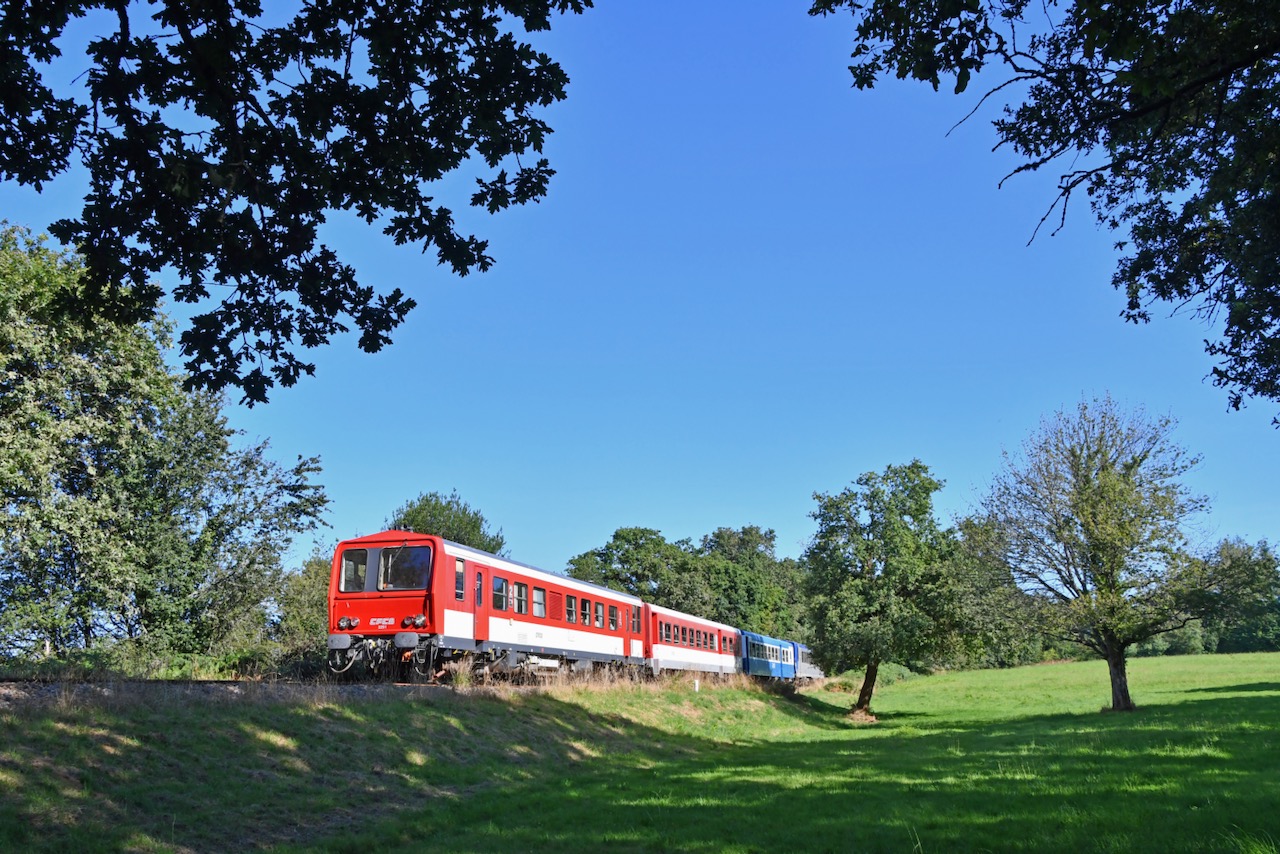
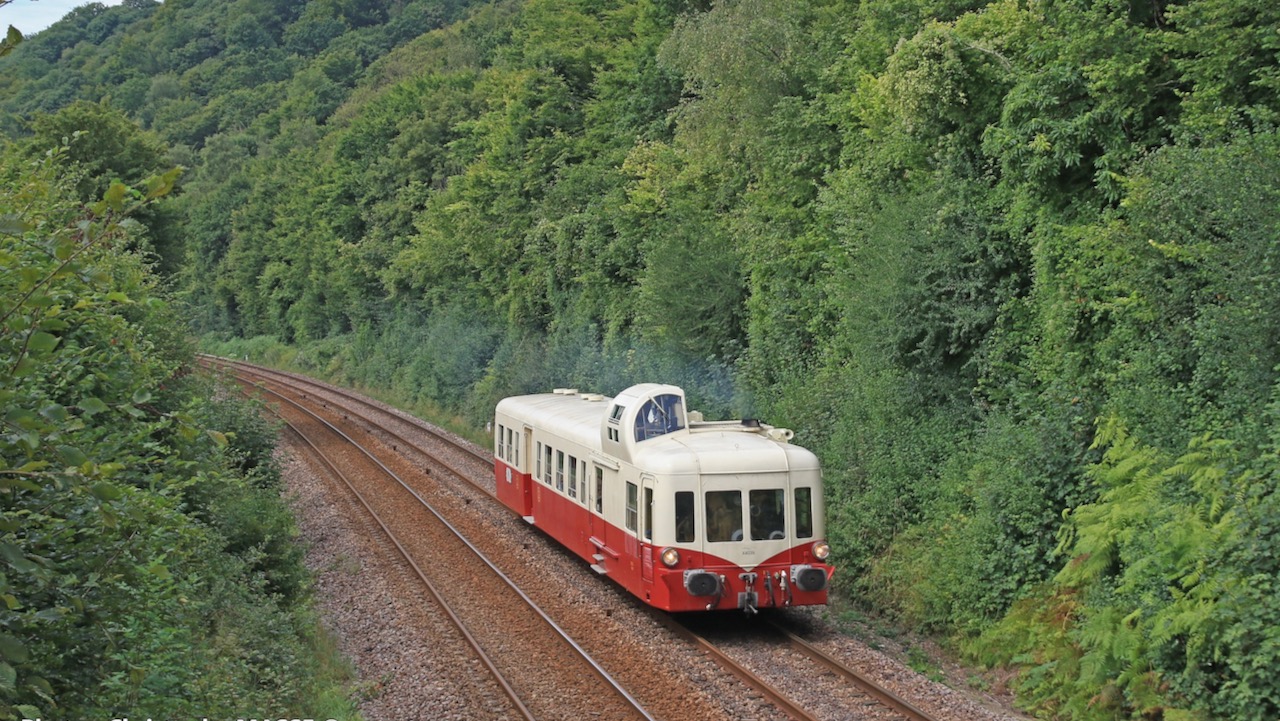
ABFC's X 4039, the only Picasso certified for mainline operation is in Normandie until the 3rd September. On Saturday 17th August it was operating between Dieppe and Rouen, seen above shortly before Montville. Photo: Christophe Masse.

Thursday 15th August saw the annual Fête de la Mer at Cayeux Sur Mer with the CFBS holding their Fête de la Gare at the station. Services on the Cayeux branch were provided by the CFBS Buffaud Robatel 0-3-1T 3714, Haine St Pierre 1-3-0T 15 and the Verney Autorail. With steam to spare Buffaud Robatel 0-3-1T 3714 is seen storming out of St Valery with a mixed train.
Photo: Jocelyne Bourneuf
Chasse-neige preservation bid
A group has been set up to preserve the two former Toulouse chasse-neige locomotives BB 8500, CN1 - 8553 and CN2 - 8556, currently waiting disposal at Toulouse. L'Association de Préservation des Chasse-Neiges Toulousain - BB8500 (APCNT-BB8500) has been established with thee aim of preserving the locomotives at Le-Tour-de Carol. Further details on the associations web site (via this link)
Opposite the two locomotives at at Toulouse Matabiau on the 6th April. Photo: Georges Turpin.
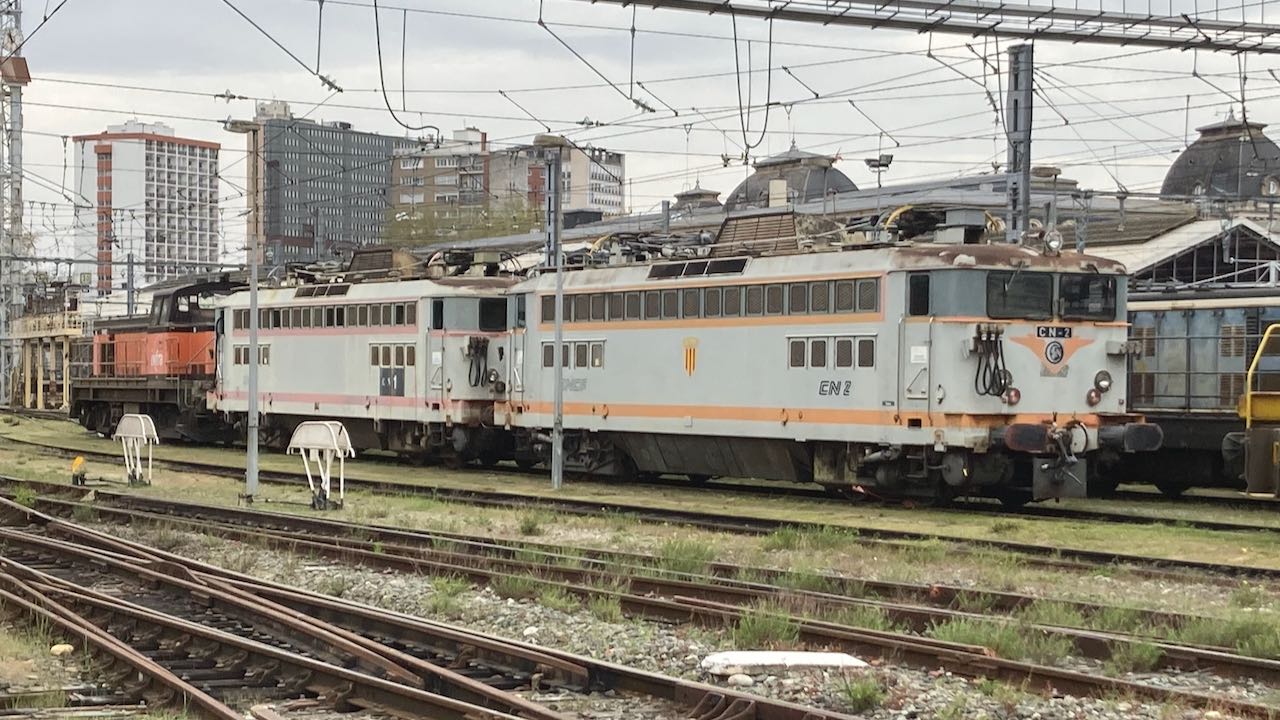
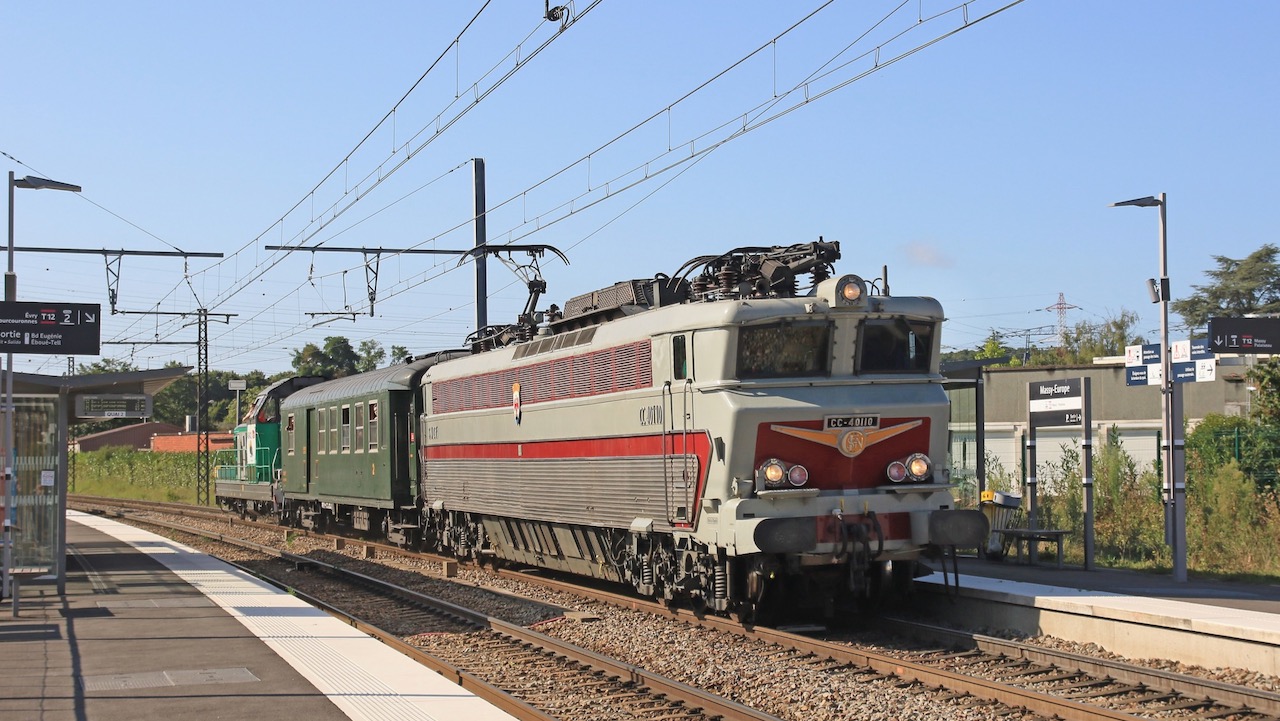
CC 40110 test run
Following nearly two years of heavy maintenance and repairs, MFPN organised a circular test run for CC 40110 at 1.5kV DC around parts of the Grande Ceinture on Sunday 25th August. The event was well advertised with MFPN circulating the route and times on social media (see opposite). CC 40110 performed without any problems and four trips are now planned; Douai (7th September), Troyes (5th October), Arras (30th November) and Amiens (14th December). More details here.
CC 40110 is seen above passing through the newT12 stop at Massy-Europe, an appropriate location for an international locomotive. Photo: Christophe Masse.
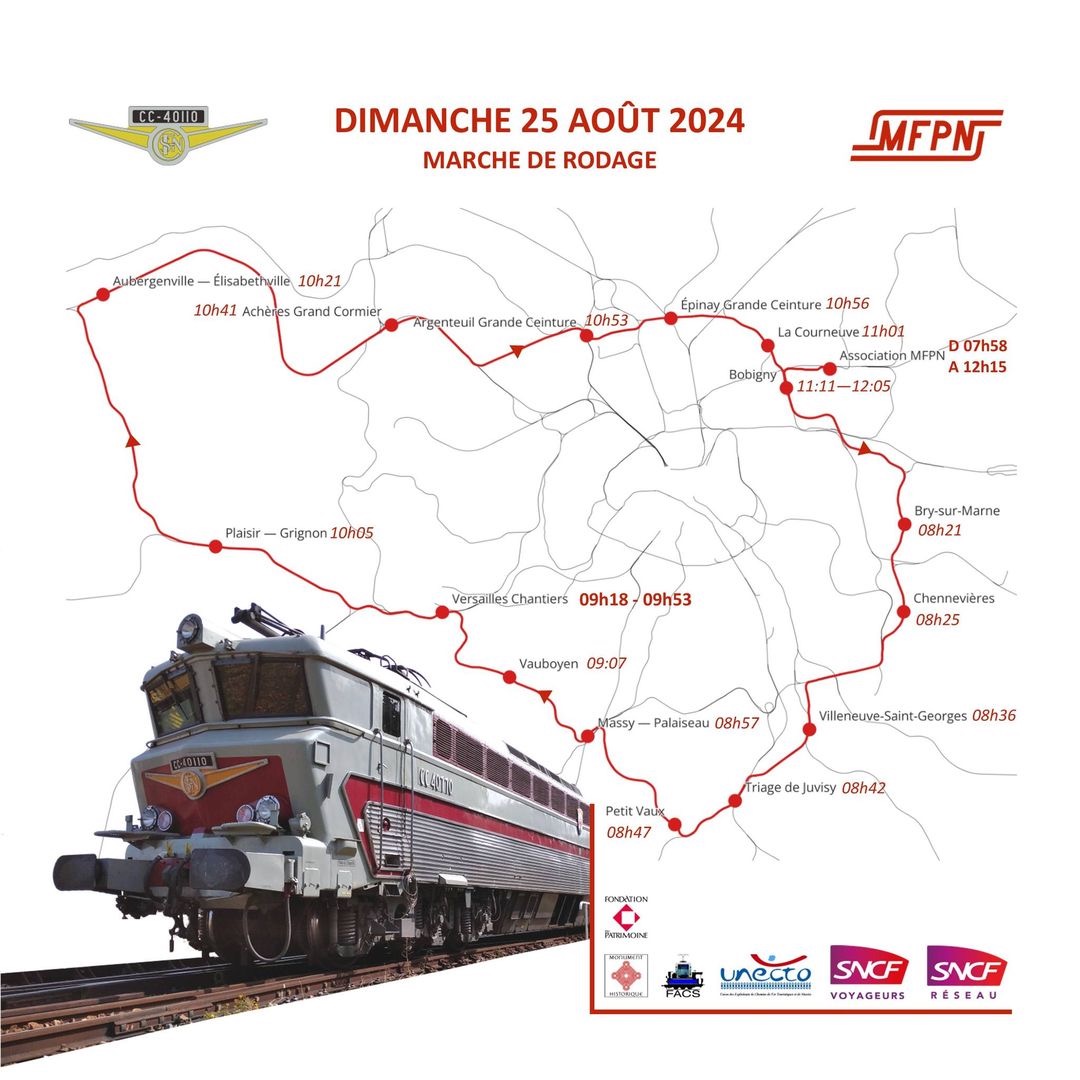
Journées européennes du patrimoine
The annual Patrimonie weekend will take place on the 21st/22nd September this year. Details of individual rail related events can be found on the SNCF website (via this link) that lists events on a regional basis. This appears to include events by preservation societies ans well as SNCF. Events range from visits to signal cabins and workshops to specials between Chambéry and Bourg-Saint-Maurice on the 21st hauled by a BB 67400 and CC6549 and CC 6558.
Urban Rail
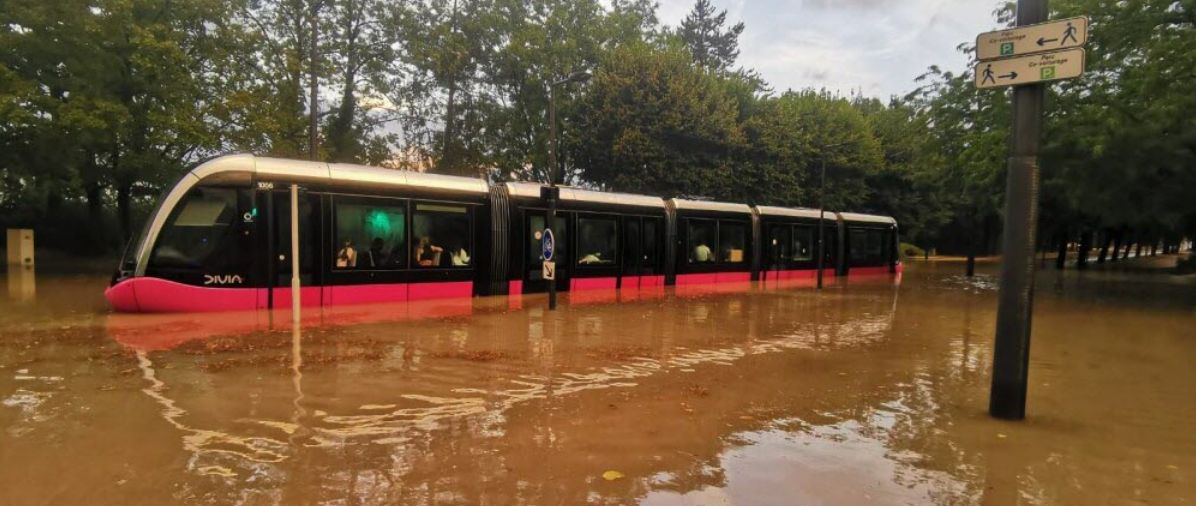
Dijon. A thunderstorm and torrential rain on the evening on 14th August caused flash-flooding, marooning a car on T1 at Grésilles-Trimolet when water reached floor level. Passengers were evacuated by the fire service. Photo: Sdis 21.
Toulouse Line C.
The first of five boring machines started work on 12th August. Marguerite de Catellan will cut 4.5km of tunnel over the next 15 months, including under the TER station at Montaudran.
Sensors have been installed on the track in various locations to use lasers to check for any ground movements during tunnel digging. See opposite.
Photo: Georges Turpin.
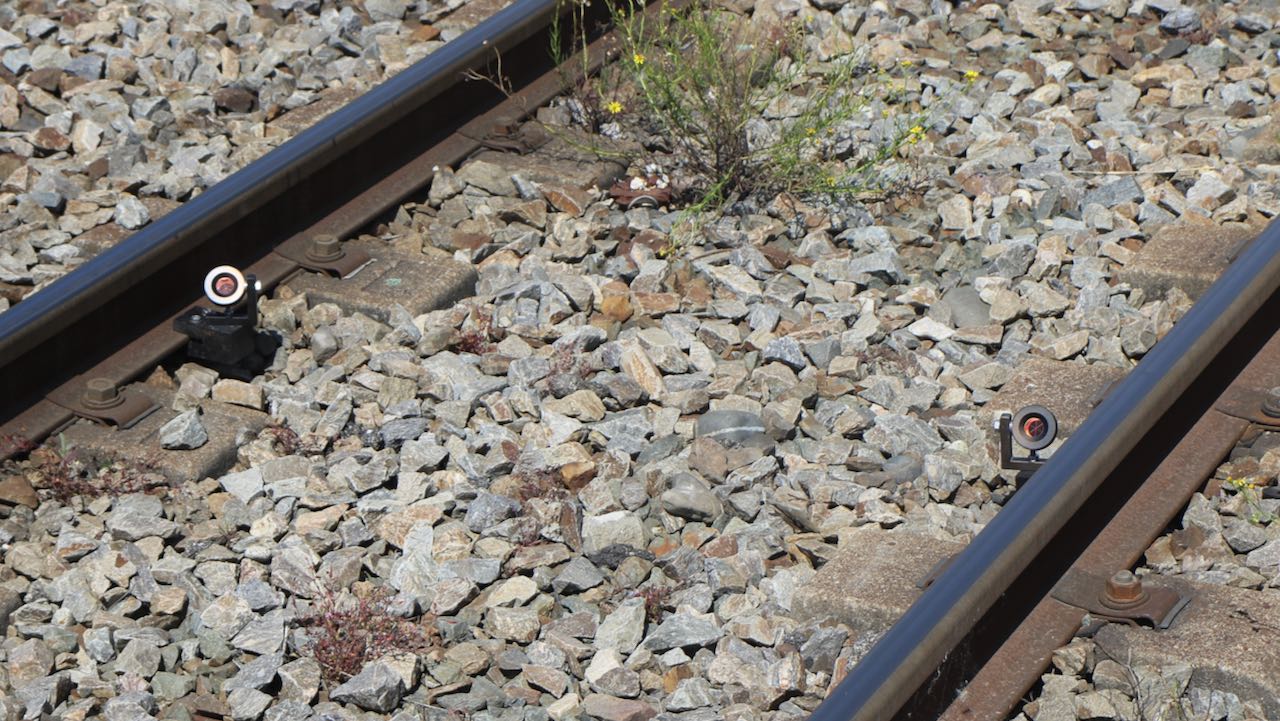
Roubaix-Tourcoing tramway
On 20th June Métropole Européenne de Lille awarded the Tramelis consortium a 10-year project management contract for development of Roubaix-Tourcoing’s tramway. Egis is the project management leader, with other members contributing expertise in urban design, environment, landscaping and documentation. The State is supporting the project with a €45 million development grant.
Agreed by MEL in the Extramobile transport master plan adopted in 2019 to cope with population growth by 2035 estimated at 115,000, the line is effectively a Y-shaped 22km extension of Lille’s metre-gauge tramway Le Mongy. It will run north-south from Neuville-en-Ferrain to Hem with an eastern branch to Wattrelos, connecting with Le Mongy at Tourcoing Gare and Eurotéléport, and with metro Line 2 at Eurotéléport and Pont de Neuville. There will be 45 stops. Construction is unlikely to start before 2028.
The Extramobile concept aims to offer high-quality service with a 6min frequency in peak hours. Parameters are yet to be fixed but local officials envisage city-centre sections as catenary-free, and the expertise of consortium members suggests a high standard of urban design. Included in the plans are new interchanges with bus routes, large areas of parkland and extensive provision of ‘safe space’ for walking, cycling and modes such as electric scooters.
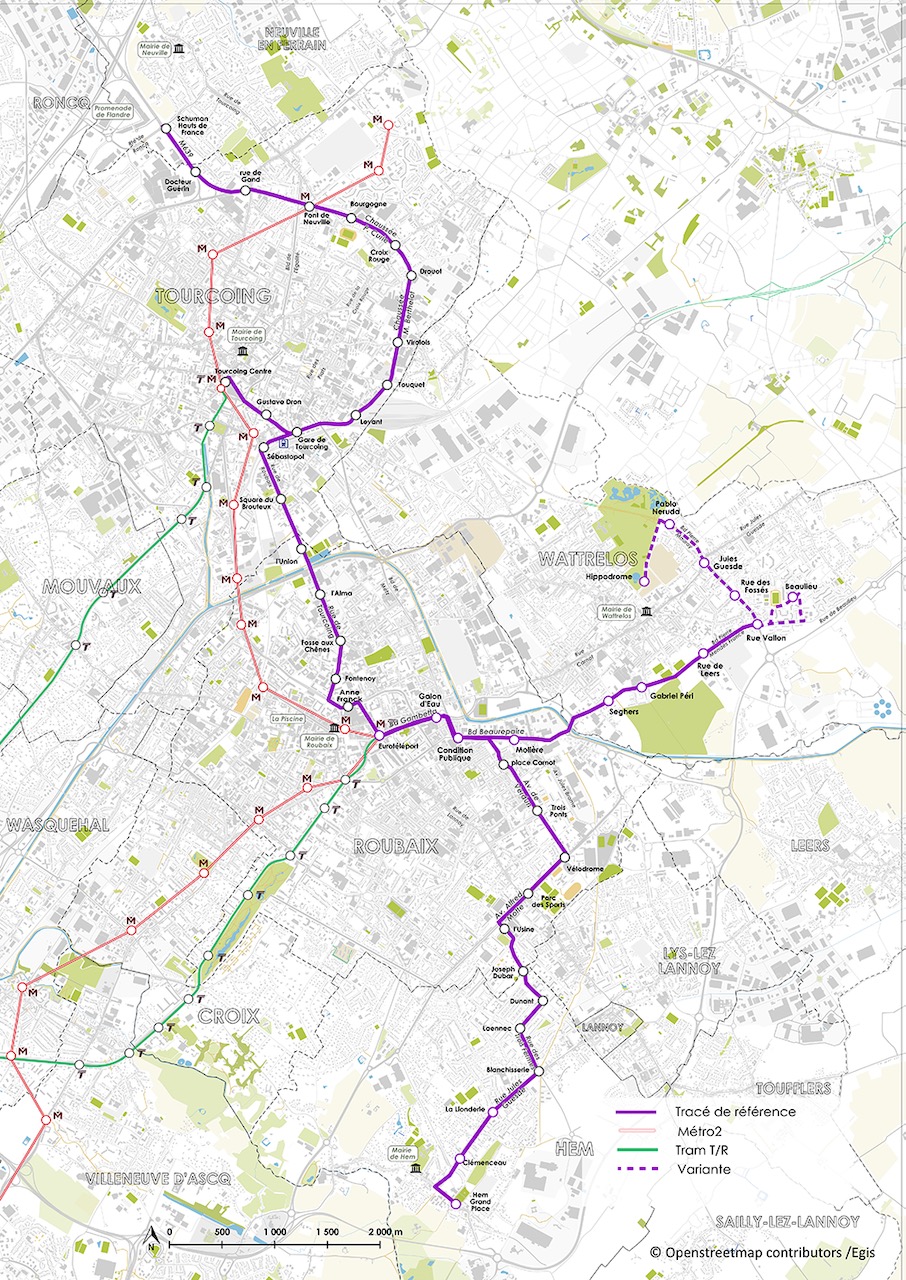
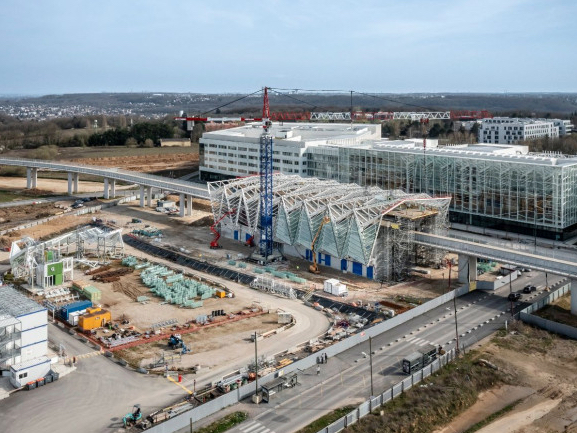

Grand Paris Express Line 18. The 35km Line 18 has some 14km elevated including the 6.7km between Christ de Saclay and Palaiseau, the longest viaduct in France. There are three elevated stations on this section, all designed by architects Atelier Novembre-Benthem Crouwel in a harmonious style. Seen left is Moulon Campus and (right) Marguerite-Perey, both due to open with the first section between Massy-Palaiseau and Christ de Saclay in 2026. The three stations draw inspiration from 19th Century railway structures, with concrete boxes each side of the viaduct supporting a steel origami-like framework which will be faced in different coloured materials, yellow for Moulon Campus and white for Marguerite-Perey.Photos: © Atelier Novembre-Benthem Crouwel Architects/LV.
Olympics. Paris transport deserved a gold medal according to reports, with few incidents and little overcrowding despite handling 4 million passengers daily, 20% of whom used newly-opened Line 14. After two weeks’ breather, RATP and SNCF geared up again from 28th August to move the Paralympics crowds whilst at the same time coping with the start of the new school year on 2nd September. In addition to augmented service on eight metro lines and RER C and E, 150 vehicles adapted for people with reduced mobility are on hand at the main line terminals and Rosa Parks Line E station.
© Peter Lovell & Chris Bushell. The French Railways Society 2024. With thanks to Georges Turpin, Didier Delattre, Christophe Masse, Jocelyne Bourneuf, David Haydock, Pete Brendon and Ben Pattison.
